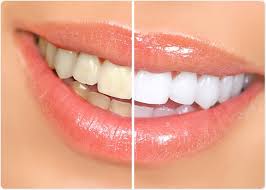Teeth whitening is a popular cosmetic dental procedure aimed at enhancing the appearance of teeth by removing stains and discoloration. Here's an overview of how it works, the different types available, and potential side effects:
How Teeth Whitening Works
Teeth whitening primarily involves the use of bleaching agents, usually hydrogen peroxide or carbamide peroxide. These agents penetrate the enamel to reach the discolored molecules within the tooth. The bleaching agents break the bonds of the discolored molecules, resulting in a whiter appearance of the teeth.
Types of Teeth Whitening
- In-Office Whitening:
- Procedure: Performed by a dentist, this method involves applying a high-concentration bleaching agent directly to the teeth. Often, a special light or laser is used to accelerate the whitening process.
- Duration: Typically completed in one visit, lasting 30-90 minutes.
- Effectiveness: Provides immediate and dramatic results, with teeth often becoming several shades lighter.
- At-Home Whitening (Prescribed by Dentist):
- Procedure: Dentists provide custom-fitted trays and a lower-concentration bleaching gel for use at home. Patients typically wear the trays for a few hours a day or overnight for several weeks.
- Duration: Results usually appear within a few days to a couple of weeks.
- Effectiveness: Can achieve similar results to in-office treatments over a longer period.
- Over-the-Counter Whitening Products:
- Whitening Strips: Thin, flexible strips coated with a bleaching gel. Applied directly to the teeth and worn for a specified time.
- Whitening Toothpastes and Mouthwashes: Contain mild abrasives or low concentrations of bleaching agents to help remove surface stains.
- Whitening Pens and Gels: Applied directly to the teeth with a brush applicator.
- Natural Remedies:
- Baking Soda: A mild abrasive that can help remove surface stains.
- Hydrogen Peroxide Rinse: A diluted solution can be used as a mouthwash.
- Fruit Peels: Some people use banana or orange peels to rub on their teeth, though scientific evidence supporting effectiveness is limited.
Side Effects of Teeth Whitening
- Tooth Sensitivity:
- Cause: Whitening agents can penetrate the enamel and reach the dentin, causing temporary sensitivity.
- Management: Use of desensitizing toothpaste or reducing the frequency of whitening treatments.
- Gum Irritation:
- Cause: Contact with bleaching agents can irritate the gums.
- Management: Ensuring proper application to avoid contact with the gums, and using protective barriers during in-office treatments.
- Enamel Damage:
- Risk: Overuse or improper application of whitening products can weaken the enamel.
- Prevention: Follow the recommended usage guidelines and consult with a dentist before starting any whitening regimen.
- Uneven Whitening:
- Cause: Existing dental work (fillings, crowns, veneers) does not respond to bleaching agents, leading to color mismatch.
- Solution: Discuss options with a dentist to ensure a uniform appearance.
Considerations and Tips
- Consult with a Dentist: Before starting any whitening treatment, it’s important to consult with a dentist to ensure it’s appropriate for your dental health and to get personalized recommendations.
- Maintain Oral Hygiene: Good oral hygiene practices can help maintain the results of whitening treatments. Brushing twice a day, flossing, and regular dental check-ups are essential.
- Avoid Staining Foods and Drinks: Limiting consumption of coffee, tea, red wine, and tobacco can help prolong the effects of whitening.
Teeth whitening can significantly enhance your smile’s appearance, but it’s important to choose the right method and be aware of potential side effects. Always seek professional advice to ensure safe and effective whitening.






Comments